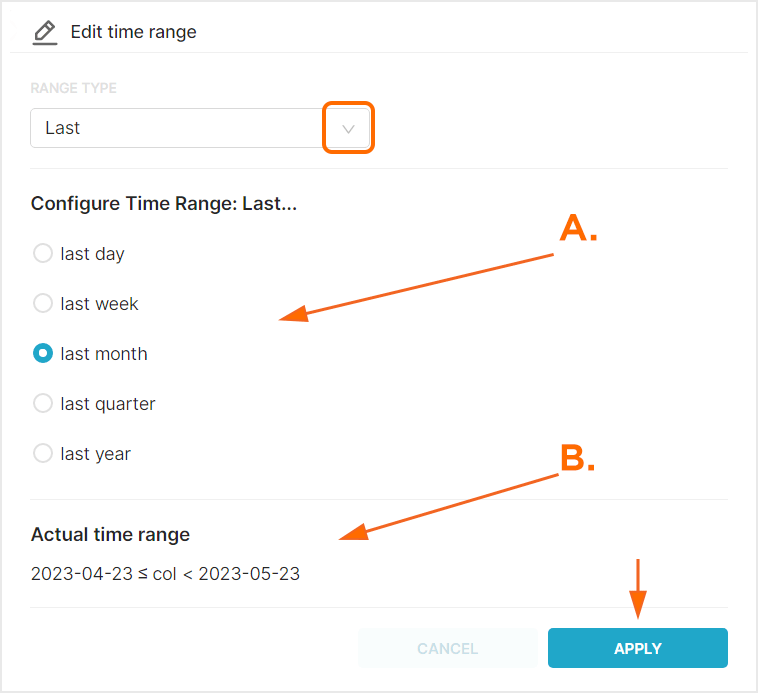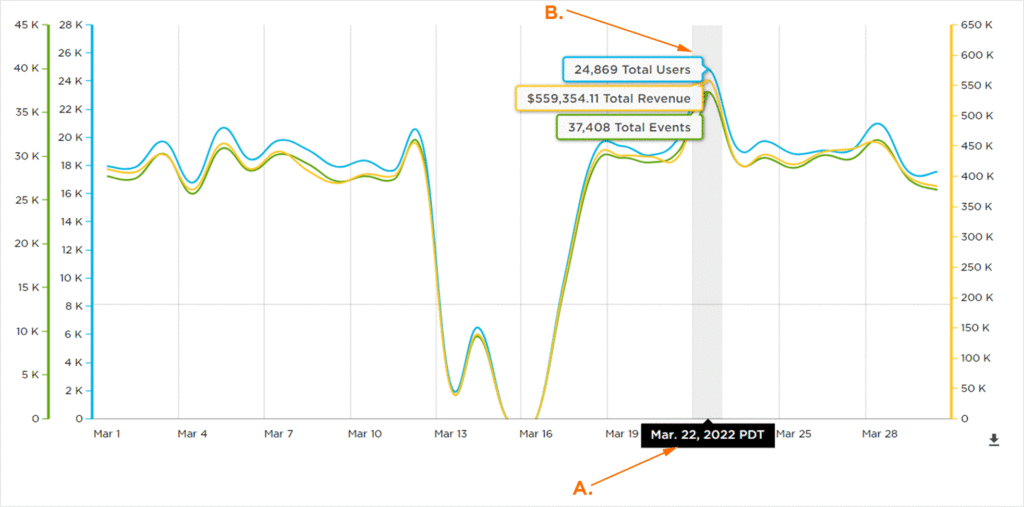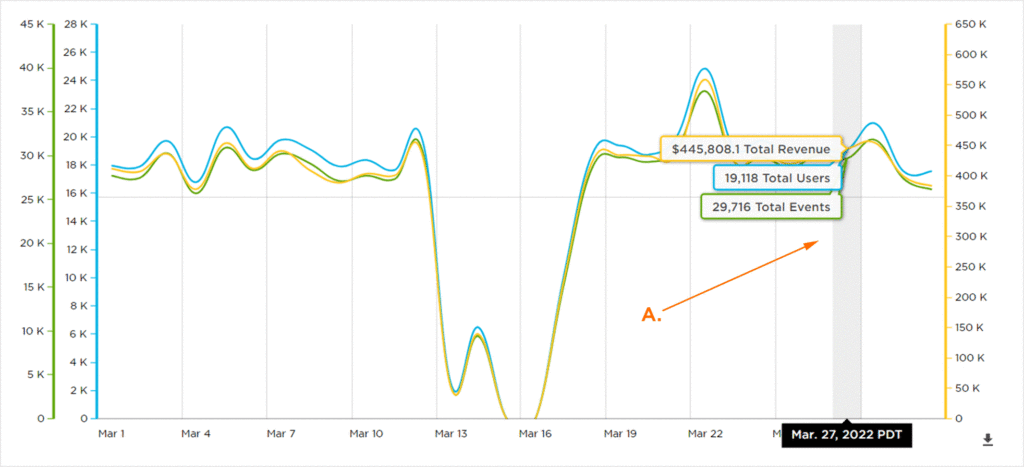The Analytics Overview page provides a visualization of the Users, Events, Revenue, and New Installs associated with a specific app. The page is divided into two main sections. The first illustrates the Users and Events; the second section illustrates New Installs by Network, Device Type and Device Version. Both sections are interactive displays allowing users to quickly and effectively navigate visually through the data.
Analytics User Interface
- Log in to Kochava.
- Select the desired Account and App.
- Select Analytics > Dashboard > Overview.
Analytics Page Tools
For more information on the tools available for this Analytics page, such as the date field, exporting device IDs, sharing the page and applying cohorts and filters, refer to our Analytics Page Tools support documentation.
Date Range:
The date range filter provides the option to refine the window of data that is displayed. The following range types and time ranges are available for selection:
- Last:
- last day
- last week
- last month
- last quarter
- last year
- Previous:
- previous calendar week
- precious calendar month
- previous calendar year
- Custom:
- Start (Inclusive):
- Relative Date/Time — This option provides a text field in which a number can be manually entered and a drop-down box where the following options:
- Days Before
- Seconds Before
- Minutes Before
- Hours Before
- Weeks Before
- Months Before
- Quarters Before
- Years Before
- Specific Date/Time — A manual date/time may be entered or the calendar and time selection tool may be used.
- Now — This is the selection of the current date and time.
- Midnight — This is the selection of the current date and the time selection of midnight or (24:00hrs).
- Relative Date/Time — This option provides a text field in which a number can be manually entered and a drop-down box where the following options:
- End (Exclusive):
- Specific Date/Time — A manual date/time may be entered or the calendar and time selection tool may be used.
- Relative Date/Time — This option provides a text field in which a number can be manually entered and a drop-down box where the following options:
- Days After
- Seconds After
- Minutes After
- Hours After
- Weeks After
- Months After
- Quarters After
- Years After
- Now — This is the selection of the current date and time.
- Midnight — This is the selection of the current date and the time selection of midnight or (24:00hrs).
- Start (Inclusive):
- Advanced:
- Start (Inclusive) — Manually enter today or a specific desired start date.
- End (Exclusive) — Manually enter today or a specific desired end date.
- Previous:
- previous calendar week
- previous calendar month
- previous calendar year
- No filter:

A. After range selection, select the desired time range.
B. Time range that will be displayed.
Filters:
Filters can be used to further refine, organize and visualize the displayed data in a method that is most beneficial. Multiple filters can be added and saved for later use.
- Click + Add Filter.
Added filters may be inclusive or exclusive. Select from the following filters categories:- App — Based on the available apps within account.
- Events — Based on Standard or Custom events.
- Location — Based on IP address.
- Attribution — Based on attributed installs and campaign attribution settings.
- Campaign — Based on campaign naming conventions.
- Device — Based on user agent.
- Traffic Verification — Based on Traffic success or failure.
- Agency — Based on the available apps within the agency account.
Once the filter category has been selected, one or more values may be added per filter. Filters can be saved and reapplied within any of the Analytics pages.
- Select the Filter drop-down menu, Select desired Filter.
- Add desired values.
- Click “X” to remove Filter.
A. Filters
B. Click “+ Add Filter” to add metric
C. Click “X” to remove metric
D. Click “X” to remove Filter and associated Metric(s)
E. Click “Clear” to remove all Filters.
Cohorts:
Within Kochava, Cohorts are groups of users that installed an app within a specific date range.
- From the Cohort drop-down menu, Select one of the following:
- All Time — Displays all Event and all Install data for the selected date range.
- All Installs — Displays all Installs data within cohort date range.
- Attributed Installs — Displays only Attributed Installs within cohort date range.
- Unattributed Installs — Displays on Unattributed Installs within cohort date range.
When a Cohort is selected, the Cohort date field will be presented. Data for users who fall within the Cohort during the Cohort date range will be visualized within the defined Analytics date range.
A. Cohort Date Range: This date range determines the group of users to display within the Analytics Date Range
B. Analytics Date Range: This date range determines the overall length of time displayed
C. Data displaying the selected Cohort within the Analytics Date Range
Currency:
By default cost data is displayed in US Dollars, however cost data may be displayed in a variety of other currency.
From the Currency drop-down menu select one of the following:
- AED
- AFN
- ALL
- AMD
- ANG
- AOA
- ARS
- AUD
- AWG
- AZN
- BAM
- BBD
- BDT
- BGN
- BHD
- BIF
- BMD
- BND
- BOB
- BRL
- BSD
- BTC
- BTN
- BWP
- BYN
- BYR
- BZD
- CAD
- CDF
- CHF
- CLF
- CLP
- CNH
- CNY
- COP
- CRC
- CUC
- CUP
- CVE
- CZK
- DJF
- DKK
- DOP
- DZD
- EEK
- EGP
- ERN
- ETB
- EUR
- FJD
- FKP
- GBP
- GEL
- GGP
- GHS
- GIP
- GMD
- GNF
- GTQ
- GYD
- HKD
- HNL
- HRK
- HTG
- HUF
- IDR
- ILS
- IMP
- INR
- IQD
- IRR
- ISK
- JEP
- JMD
- JOD
- JPY
- KES
- KGS
- KHR
- KMF
- KPW
- KRW
- KWD
- KYD
- KZT
- LAK
- LBP
- LKR
- LRD
- LSL
- LYD
- MAD
- MDL
- MGA
- MKD
- MMK
- MNT
- MOP
- MRU
- MVR
- MWK
- MXN
- MYR
- MZN
- NAD
- NGN
- NIO
- NOK
- NPR
- NZD
- OMR
- PAB
- PEN
- PGK
- PHP
- PKR
- PLN
- PYG
- QAR
- RON
- RSD
- RUB
- RWF
- SAR
- SBD
- SCR
- SDG
- SEK
- SGD
- SHP
- SLL
- SOS
- SRD
- SSP
- STD
- STN
- SVC
- SYP
- SZL
- THB
- TJS
- TMT
- TND
- TOP
- TRY
- TTD
- TWD
- TZS
- UAH
- UGX
- USD
- UYU
- UZS
- VES
- VND
- VUV
- WST
- XAF
- XAG
- XAU
- XCD
- XDR
- XOF
- XPD
- XPF
- XPT
- YER
- ZAR
- ZMW
- ZWL
Analytics Overview Chart
The Analytics Overview chart is a representation of User Activity, Event Volume and Revenue associated to the app within the specified date range.
NOTE: When leveraging Cross App functionality User Activity, Event Volume and Revenue data for all apps within the App Name filter will be displayed. For more information about adding apps using the filter feature, refer to our Analytics Page Tools support documentation.
Users:
Displays New Users (the number of users who installed the app during the specified time range) and Total Users (the count of all distinct users who performed an event during the specified time period). Each of the sections may be selected to display within the graph and is represented by the blue line.
Event Volume:
Displays the Per User events and the Total number of events that occurred during the selected date range. Either of the sections may be selected to be displayed within the chart, and is represented by the green line.
Revenue:
Displays the Per User amounts and the Total amount purchased within the selected date range. Either of the sections may be selected to display within the chart and are represented by the yellow line.

A. New: Users initial install within time frame. Total: All users performing an event within time frame.
B. Per User: Average number of events per user within time frame. Total: All events within time frame.
C. Per User: Average amount spent per user within time frame. Total: All revenue within time frame.
The Analytics Overview chart displays data associated with selections within the Users, Event Volume and Revenue categories; the graphical representation of the data updates in response to alternate selections within the Users, Event Volume and Revenue categories.
Each category (Users, Event Volume and Revenue) is represented on the interactive chart by a vertical axis which is color coded for easy identification. The horizontal axis represents the date range selected, and all totals are cumulative along the duration of the date range.
A. Horizontal Axis displaying time frame
B. Event Volume vertical axis
C. Users vertical axis
D. Revenue vertical axis
Mousing over any part of the interactive chart will display the corresponding data for each category (Users, Event Volume and Revenue) for the corresponding date within the time frame. Moving the mouse along the horizontal axis will display the data for any of the dates within the selected time frame.

A. Current Highlighted Date
B. Users, Event Volume, and Revenue data for highlighted date
Changing the selections within the Users, Event Volume and Revenue categories will update any corresponding mouseover data within the interactive chart.

A. Mouseover data is updated to reflect the changed Users, Event Volume and Revenue selections
Downloading the Analytics Overview Chart Data
The data displayed within the Analytics Overview chart can be downloaded in the following formats:
Download Graphically:
Click the Download Button > Select a file format:
- Download PNG image
- Download JPG image
- Download PDF document
- Download SVG vector image
Download Data:
Click the Download Button > Select a file format.
- Download CSV
- Download XLSX
Print Data:
Click the Download Button > Select Print chart.
New Installs Donut Charts
The New Installs donut chart displays app installs by Network, Device Type, Device Version and OS Version. Data can be easily viewed within the charts by mousing over any of the individual sections. A display will appear detailing the Section Title, Section Total and Percentage of the total the section represents. Each section of data has been color coded for easy identification.
A. Mouseover to view associated data
B. Network details
C. New Installs displayed by Network, Device Type and Device Version
The data contained within each chart can also be viewed beneath the charts in alphanumeric form. Each instance displays the Section Title, Section Total and Percentage of the total the section represents. By default, the top three sections are displayed.
Click Down Arrow (e.g., 1/9 ▼) under any of the alphanumeric sections to scroll through the remainder of the data. Mousing over any of the data sets within the alphanumeric sections will highlight and display the section data within the donut chart. Click Up Arrow (e.g., 1/9 ▲) under any of the alphanumeric sections to scroll up through the sections.
A. Alphanumeric Sections
B. Click one to scroll through the alphanumeric data
C. Section highlighted by mousing over alphanumeric data
Within the alphanumeric sections, individual data sets can be disabled by clicking on the set, in order to refine the displayed donut charts. When a data set is disabled, the text will turn grey with a line through it and the associated chart piece will be removed.
A. Fully displayed donut chart and alphanumeric sections
B. Donut chart adjusted with disabled data set
C. Disabled data set, data does not appear in donut chart
Downloading the Donut Chart Data
The data displayed within the donut charts and alphanumeric sections can be downloaded in the following formats:
Download Graphically:
Click the Download Button > Select a file format:
- Download PNG image
- Download JPG image
- Download PDF document
- Download SVG vector image
Download Data:
Click the Download Button > Select a file format:
- Download CSV
- Download XLS
Print Data:
Click the Download Button > Print chart.
